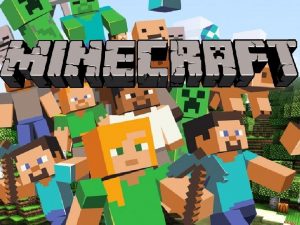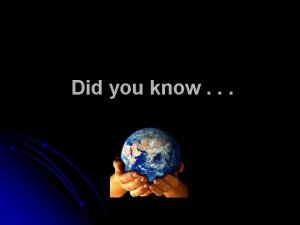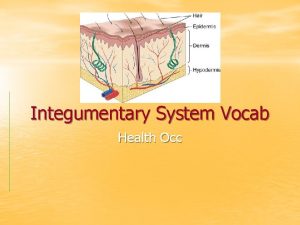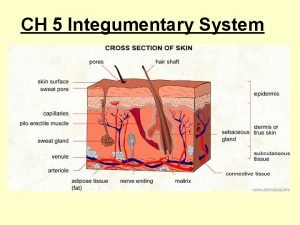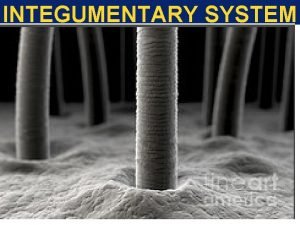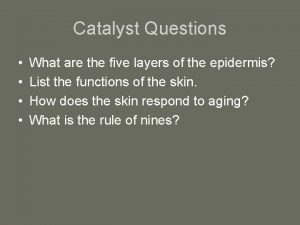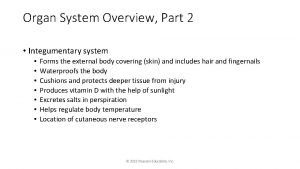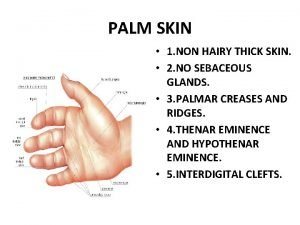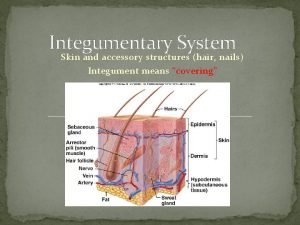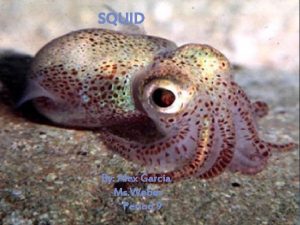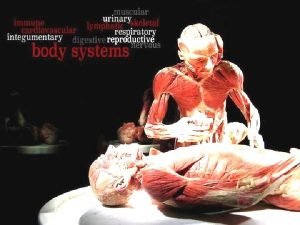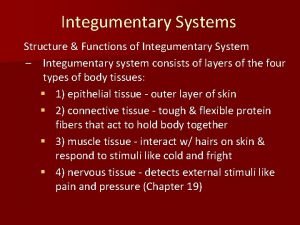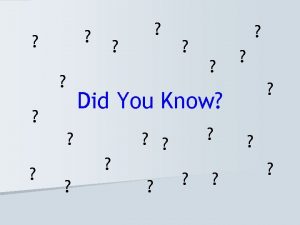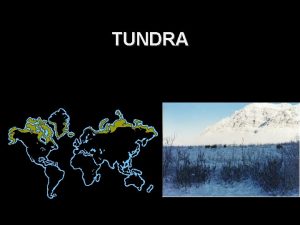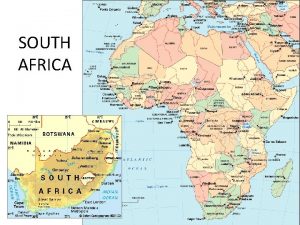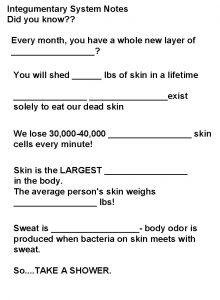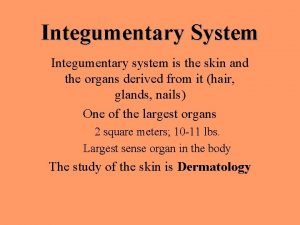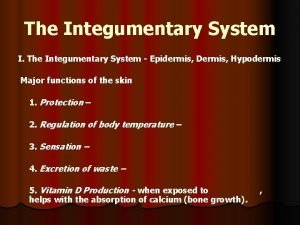Integumentary system Did you know A fingernail takes













































- Slides: 45

Integumentary system: Did you know? • A fingernail takes about 6 months to grow from base to tip. • A human being loses an average of 40 to 100 strands of hair a day. • Each square inch of human skin consists of 20 feet of blood vessels. • Every square inch of the human body has an average of 32 million bacteria on it. • Humans shed about 600, 000 particles of skin every hour - about 1. 5 pounds a year. By 70 years of age, an average person will have lost 105 pounds of skin.

What is the integumentary system? • • Largest organ in the body Integumentary = “covering” Why is skin called an organ? Components: – Skin (cutaneous membrane) and epidermal derivatives (glands, hair follicles, nails)

What are the regions of the skin? • Epidermis and dermis – Epidermis: keratinized squamous epithelium – Dermis: areolar and dense irregular CT • Hypodermis (subcutaneous layer): loose CT (areolar and adipose) – Not technically skin

What does the skin do? • Communication: sensory receptors • Site of waste secretion: sweat • Protection: serves as physical barrier against – Abrasion, water loss, microorganisms, UV damage – Anti-microbial soaps (acid mantle, CDC study)

What does the skin do? • Body temperature regulation – Hot: vasodilation, sweat – Cold: vasoconstriction, goose bumps • Metabolic function: – vitamin D synthesis • Made from cholesterol • Important for Ca 2+ absorption in small intestine – Prevents folate destruction (reproductive fitness protection)

What does the hypodermis do? • Allows skin to move freely, shock absorber, insulates against heat loss • Not present everywhere – E. g. none on shin

Which of these events occur as a result of a decrease in body temperature? A. blood vessels in the epidermis dilate, at first B. blood vessels in the dermis constrict if skin temperature falls below 15 degrees C C. contraction of arrector pili muscles D. sweat is produced E. all of these

The Layers of the Epidermis

How many types of skin are there? • Two types – Thin skin • Most parts of the body • All but stratum lucidum (total = four layers) • 75 -150 µm thick

How many types of skin are there? – Thick skin • Palms & soles • Includes stratum lucidum (total = five layers) • 400 -600 75 -150 µm thick

Compare them against each other Thin Skin Thick Skin

Let’s look at the layers of the epidermis… • Stratum basale – – – Closest to blood supply Regenerative layer keratinocytes Contains melanocytes Cancers include _____ and ______

• Stratum spinosum – Still some division – Cancer is called ____

• Stratum granulosum – Organelles disintegrate granules

• Stratum lucidum – Only present in thick skin

• Stratum corneum – Packed keratin

Let’s look at them all together

So, what are all the cells found in the epidermis? • Keratinocytes = most common • Melanocytes • Langerhans (dendritic) cells • Merkel (tactile) discs

What types of cells are in the epidermis? • Keratinocytes: make keratin – Structural protein, type of intermediate filament (tough) • Hydrophobic! – Desmosomes hold keratinocytes together, attach them to basement membrane • Connections required for skin integrity • What happens without them? Pemphigus bulgaris Healthy skin

What types of cells are in the epidermis? • Melanocytes – Spider-like pigment cells, make/secrete melanin – Keratinocytes endocytose pigment and concentrate on sunny side – Melanin absorbs UV, protects basale layer from damage • Sunlight increases melanin production – If cancerous: melanoma

In which layer of epidermis do the nucleus and other organelles disintegrate, and the cells die? A. stratum basale B. stratum corneum C. stratum granulosum D. stratum lucidum E. stratum reticularis

Which of these qualities must a medication possess if it is absorbed from a skin patch? A. lipid-soluble B. water-soluble C. must contain keratin D. must be slightly acidic E. must contain melanin

The Dermis

What about the dermis? • • Strong, flexible Mostly dense irregular CT With fibroblasts, wandering defense cells Highly vascularized: control body heat, nourish epidermis • Large component of sensory receptors

What’s the purpose of the dermis? • Blood supply • Sensory perception • Structural integrity

What two layers make up the dermis? • Papillary layer – Areolar CT – Fingerprints – Open spaces for ____ • Reticular layer – Dense irregular CT – Collagen fibers in all directions to _______

What else is found in the dermis? • Hair follicle – Note: epidermis dips down here • Sweat glands (more later) • Blood vessels • Nerves • Arrector pili muscle

What are arrector pili? • Small, smooth muscles • One per each hair on your body • Goose bumps

Skin Derivatives

What are some examples of skin derivatives? • • Hair, hair follicles Sebaceous glands Sweat glands Nails

What do I need to know about hair? • Three zones of keratinized cells – Bulb: where hair originates in dermis • Nerves surround – Root • Remainder of hair in follicle – Shaft is portion outside epidermis

What do I need to know about hair? • Three layers to hair – Medulla • Core of loosely arranged cells and air space – Cortex • Densely packed keratinized cells – Cuticle • One layer of scaly cells

What do I need to know about hair? • Arrector pili: smooth muscle

What are nails? • Modified epidermis – Hard, keratinized layers on a nail bed of epidermal cells – Three parts • Root (embedded in skin) – Root contains nail matrix (stratum basale) • Body • Free edge – Cyanotic: nail beds bluish

What are sweat glands? • Sweat (sudoriferous) glands – 3 -4 M/person – Insensible sweat

What are sweat glands? • Two types: merocrine and apocrine • Merocrine (AKA eccrine) – Most common • all but nipples, axillary and external genitalia – Secretes via exocytosis on apical side – Sweat is blood filtrate – Sympathetic nervous system

What are sweat glands? • Apocrine: axillary and groin areas – Larger glands, type of eccrine – Ducts empty into hair follicles • Secrete sweat, fatty acids and proteins • Bacterial break down of fatty acids causes odor – Mammary: modified sweat gland – Ceruminous: secrete wax • Only in auditory canal

What are sebaceous glands? • Holocrine glands: excrete broken down cell – Sebaceous glands: oilproducing glands of scalp

What are some common skinrelated conditions? • • Erythema Jaundice Bronzing Pallor Albinism Hematoma Hemangiomas—if you have them, you’ve had them your entire life!

The specific layer that shapes the ridges for fingerprints and footprints is the A. hypodermis. B. papillary layer of the dermis. C. reticular layer of the dermis. D. underlying muscle layer. E. superficial bony layer.

In which of these layers are melanocytes found? A. dermis B. hypodermis C. stratum corneum D. stratum basale E. stratum lucidum

Arrector pili muscles A. consist of skeletal muscle fibers. B. are attached directly to the hair shaft. C. contract in response to frightening situations. D. cause sweat glands to contract. E. assist in the production of sebum.

How does the skin repair itself? • Two repair processes (see Ch. 5) – Fibrosis: production of fibrous CT (scar) – Regeneration: replacement of damaged tissue with same tissue type – Both repair processes occur in skin – Scars = fibroblasts

Skin graft

Scar formation results from the efforts of which cells? • • • A. melanocytes B. fibroblasts C. keratinocytes D. fibrocytes E. Langerhans (dendritic) cells
 Navy earrings regulation
Navy earrings regulation Nail structure and growth
Nail structure and growth Fuiyou
Fuiyou Did you know facts about tea
Did you know facts about tea Direct and reported speech worksheet
Direct and reported speech worksheet You are
You are Did you know
Did you know What will you do this weekend
What will you do this weekend What is the suffix of friendship
What is the suffix of friendship Shoplifting facts
Shoplifting facts What is the suffix of false
What is the suffix of false How do you pronounce integumentary
How do you pronounce integumentary Glands in integumentary system
Glands in integumentary system Integumentary system vocabulary
Integumentary system vocabulary Integumentary system of pig
Integumentary system of pig Organum germinativum
Organum germinativum The integumentary system facts
The integumentary system facts The integumentary system exercise 7
The integumentary system exercise 7 Integumentary system vocabulary
Integumentary system vocabulary Integument medical term
Integument medical term Integumentary system
Integumentary system Integumentary system assessment
Integumentary system assessment Integumentary system analogy
Integumentary system analogy The integumentary system
The integumentary system The integumentary system
The integumentary system Integumentary system components
Integumentary system components Effects of aging on the integumentary system
Effects of aging on the integumentary system Section 36-3 the integumentary system
Section 36-3 the integumentary system Integumentary system
Integumentary system Integumentary system
Integumentary system Unit 3 integumentary system
Unit 3 integumentary system Examples of homeostatic imbalances of the skin
Examples of homeostatic imbalances of the skin Dermal structure
Dermal structure 6 functions of the integumentary system
6 functions of the integumentary system Skin cancer
Skin cancer Urinary system interesting facts
Urinary system interesting facts Integumentary system
Integumentary system Integumentary system
Integumentary system Integumentary system cpt coding guidelines ppt
Integumentary system cpt coding guidelines ppt Integumentary system the integument epidermis coloring page
Integumentary system the integument epidermis coloring page Interinsic
Interinsic Integumentary accessory organs
Integumentary accessory organs Integumentary system
Integumentary system Excretory and integumentary system
Excretory and integumentary system Squid integumentary system
Squid integumentary system Body system foldable
Body system foldable





